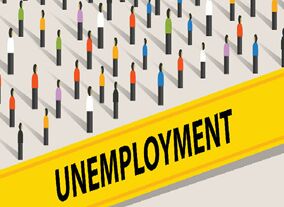零失业率并不是一件好事
|
While on the surface it appears that a 0% unemployment rate would be terrific for the citizens of a country, having a small amount of unemployment is actually desirable. To understand why we need to look at the three types (or causes) of unemployment. Cyclical Unemployment is defined as occurring "when the unemployment rate moves in the opposite direction as the GDP growth rate. So when GDP growth is small (or negative) unemployment is high." When the economy goes into recession and workers are laid off, we have cyclical unemployment.
Cyclical unemployment occurs when an economy's output deviates from potential GDP- i.e. the long-term trend level of output in an economy. When an economy's output is higher than the level of potential GDP, resources are utilized at levels higher than normal and cyclical unemployment is negative. Conversely, when an economy's output is lower than the level of potential GDP, resources are utilized at levels lower than normal and cyclical unemployment is positive. Put simply, cyclical unemployment is unemployment associated with business cycles- i.e. recessions and booms. Frictional Unemployment: We define frictional unemployment as "unemployment that comes from people moving between jobs, careers, and locations." If a person quits his job as an economics researcher to try and find a job in the music industry, we would consider this to be frictional unemployment. Frictional unemployment is unemployment that comes from people moving between jobs, careers, and locations- in other words, unemployment that arises because most people don't enter into a new job immediately after exiting an old one (voluntarily or involuntarily). Frictional unemployment is not thought to be a big problem from a policy standpoint because it is entirely reasonable that people would take some time to find a job that is a good match rather than take the first opportunity that comes along. Technology that helps to match workers with jobs and streamline the interview and hiring process most likely result in the amount of frictional unemployment that exists in an economy. Structural Unemployment: We define structural unemployment as "unemployment that comes from there being an absence of demand for the workers that are available". Structural unemployment is often due to technological change. If the introduction of DVD players cause the sales of VCRs to plummet, many of the people who manufacture VCRs will suddenly be out of work. By looking at these three types of unemployment, we can see why having some unemployment is a good thing. Most people would argue that since cyclical unemployment is the by-product of a weak economy, it is necessarily a bad thing, though some have argued that recessions are good for the economy. What about frictional unemployment? Let's go back to our friend who quit his job as an economic research to pursue his dreams in the music industry. He quit a job he disliked to attempt a career at the music industry, even though it caused him to be unemployed for a short while. Or consider the case of a person who is tired of living in Flint and decides to make it big in Hollywood and who arrives in Tinseltown without a job. A great deal of frictional unemployment comes from people following their hearts and their dreams. This is certainly a positive type of unemployment, though we would hope for these individuals' sakes that they do not stay unemployed for too long. Finally, structural unemployment. When the car became commonplace, it cost a lot of buggy manufacturers their jobs. At the same time, most would argue that the automobile, on net, was a positive development. The only way we could ever eliminate all structural unemployment is by eliminating all technological advancement. By breaking down the three types of unemployment into cyclical unemployment, frictional unemployment, and structural unemployment, we see that an unemployment rate of 0% is not a positive thing. A positive rate of unemployment is the price we pay for technological development and for people chasing their dreams. |









